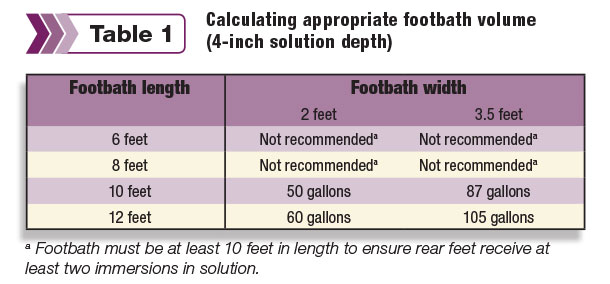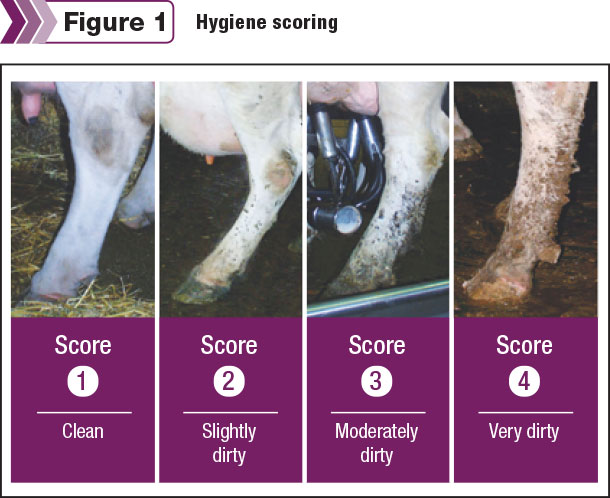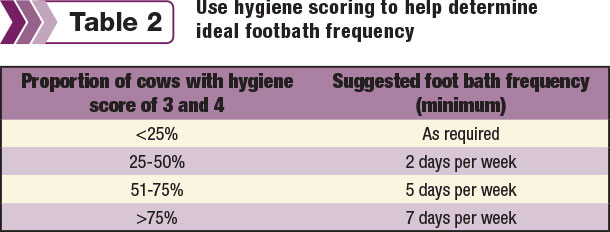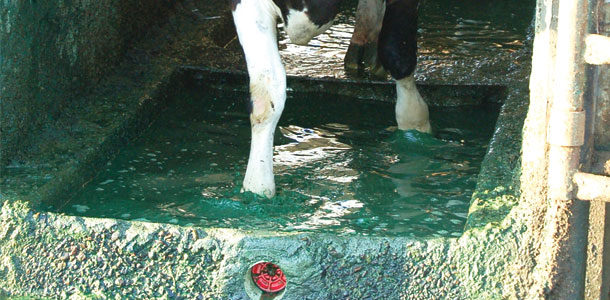Many dairy producers rely on footbath programs to help prevent and control active and chronic infectious claw lesions, such as digital dermatitis (DD), in their herds. Maximizing the effectiveness of a footbath program hinges on three key factors: foot hygiene, proper footbath design (size, length and depth) and effective footbath management (chemical concentration, cow passes per change and frequency of use).
Footbathing can be used to quickly and effectively treat a large number of cattle, no matter the type of operation. However, a footbath system that isn’t properly designed and managed can actually do more damage than good. A poorly managed footbath can become a vector for spreading infectious foot diseases throughout a herd.
Following are some common questions (and answers) to keep in mind when evaluating the effectiveness of the footbath program on a dairy.

Can footbaths be usedto treat active cases of DD?
Footbaths are a lameness prevention tool designed to help avoid subclinical and chronic cases of DD from progressing into acute, clinical lesions. Footbaths should not be used to treat clinical cases of DD. The only solution to reduce the number of active DD lesions is topical treatment (on an individual animal basis).
Early topical treatment helps reduce the duration of the infectious period for DD lesions and increases cure rates. Consequences of delayed treatment include increased lesion recurrence (chronic lesion development) and transmission of DD to healthy animals.

Where is the bestlocation for a footbath?
Footbaths should be located on a level surface in an area regularly traveled by cattle. Cows should enter a clean, dry area after passing through the footbath.

How long should a footbath be?
An ideal footbath should be 10 to 12 feet long. A minimum length of 10 feet ensures rear feet receive at least two immersions in the footbath solution.

How wide should a footbath be?
Footbaths should be 1.6 to 2 feet wide. This is wide enough to ensure cows can walk through comfortably while minimizing the amount of footbath solution and, hence, the amount of chemical needed to charge the footbath.

What is the recommended height for a footbath?
The sidewalls of a footbath should be sloped from a height of 3 feet above the floor of the bath to the upper edge of the bath, and the sides should be enclosed to create a tunnel. Sloped walls (70 degrees recommended) make cows feel at ease, not claustrophobic, without slowing down cow flow. In addition, solid sides will save solution and help maintain a consistent solution depth.

How high shouldthe step-in height be?
A 10-inch step-in height is recommended. It has been proven that cows have no problem with a curb of this height. The higher step-in height increases the number of foot immersions in the bath.

Is there a minimum depthof solution recommended?
To ensure full immersion of the hoof in solution, maintain a minimum depth of 4 inches. If the solution is too shallow, it will not allow for adequate penetration of the chemical solution into the interdigital space between the claws. For more information about the appropriate footbath volume (based on 4-inch solution depth), refer to Table 1.


How frequently shoulda footbath be used?
Footbaths should be used on consecutive days each week, based on hygiene scoring (Figure 1) or relapse rates of chronic DD cases. Foot and leg hygiene will help determine the number of days required (Table 2). Dirtier cows require more frequent footbathing. On non-footbath days, keep hygiene in check with a soap bath (1 quart of soap to 25 gallons of water, 1 percent solution).



Should cows be ableto bypass a footbath?
On days when the footbath is not being used, cows should be able to bypass permanent footbaths.

How often should footbath solution be changed?
A common industry standard is to change footbath solution after every 100 to 300 cows. However, frequency will vary depending upon cow hygiene scores, type of disinfectant or chemical concentration used, weather conditions and the prevalence of DD in the herd. Keep in mind manure deactivates chemicals used in footbaths.
Be sure to alternate times for replenishing footbaths with fresh solution so each group of cows has access to fresh solution. In addition, it is important to thoroughly drain the footbath and rinse it with water before mixing a new batch of solution. PD
PHOTO: Footbaths should be designed with sidewalls sloped from a height of 3 feet above the floor of the bath to the upper edge of the bath and enclosed sides to create a tunnel. Walls sloped at 70 degrees promote cow flow. Photo courtesy Zinpro.







